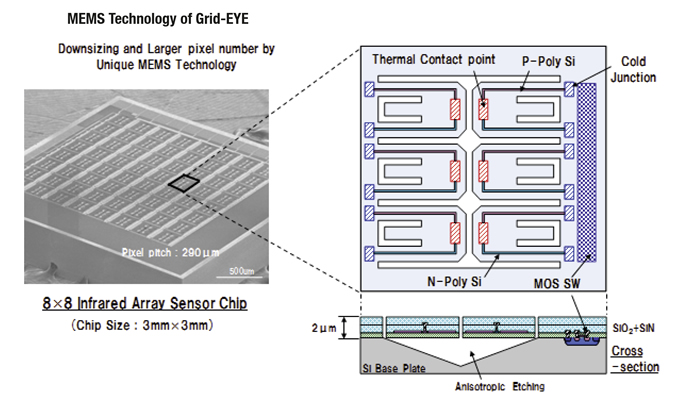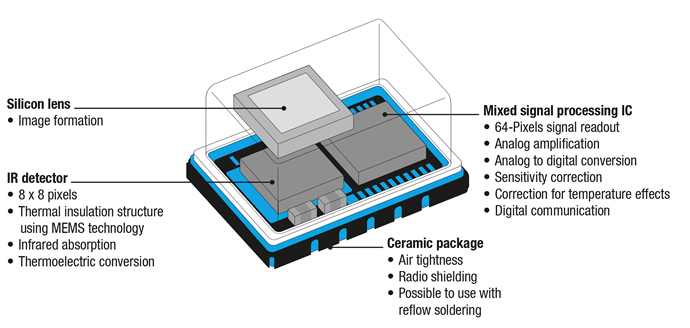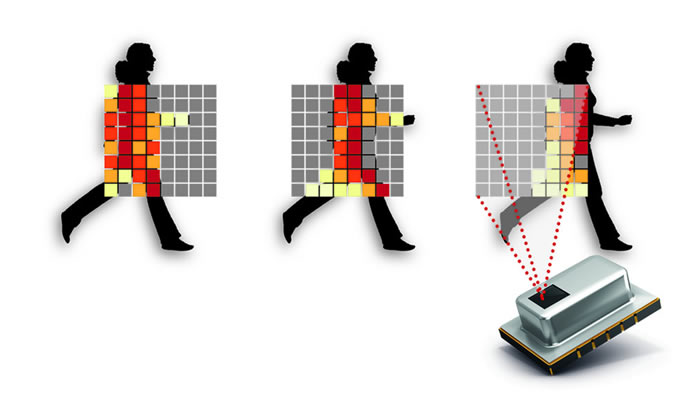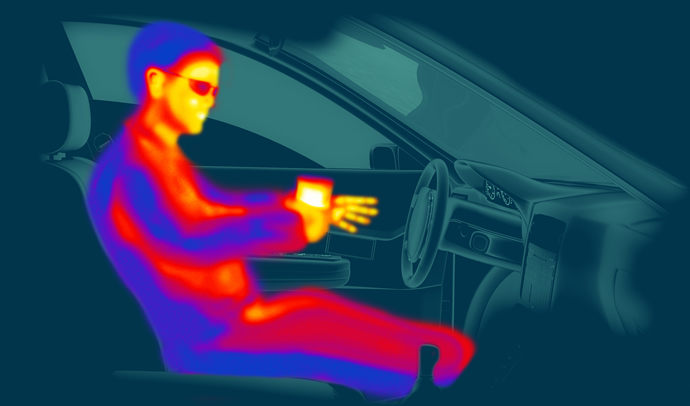What’s fuelling demand for IR grid sensors?
Thermopile sensor arrays can solve smart buildings’ challenges without compromising privacy, writes Sally Ward-Foxton. Image left: Melexis’ 32x24 pixel thermopile array, plus its optics, fits into a 4-pin TO-39 can
As electronic sensor systems turn buildings into smart homes and smart offices, there is a growing need for occupancy detection technology to tell systems such as lighting and HVAC (heating, ventilation and air conditioning) whether anyone is present in certain rooms or areas. If no-one is present, these systems may be shut down to save electricity.
Certain other smart building functions can make use of people counting or people tracking information to make buildings work better and more efficiently. Cameras in every room, linked to image processing software, would be an obvious solution for occupancy detection, but they are expensive, and there are numerous issues surrounding individuals’ privacy and the security of confidential information.

Above: Figure 1. Thermopile arrays are constructed using MEMS technology (this is the Panasonic Grid-Eye sensor)
IR sensor arrays have been proposed as a solution that can detect the presence of a person or people, while preserving their privacy. Replacing older IR detection technologies such as photodetectors based on photoelectric effects and pyroelectric sensors, modern IR sensor arrays use thermopile technology, a MEMS technology based on the Seebeck effect (Figure 1), the same effect that’s used in thermocouples. Thermopile sensor arrays are available as ‘heat cameras’ with a small number of pixels in a grid that can be used to detect people. They are compact, cost effective and don’t need a power source.
Two different types of IR grid array sensors were launched at electronica, both targeting people detection in smart homes and buildings, amongst other applications.
Second generation performance
Panasonic showed off a second generation of its Grid-Eye IR sensor array. Following the launch of the original Grid-Eye series, which were the first thermopile sensor arrays to be made available in a surface mount package, Grid-Eye II uses the same ceramic packaging technology enabling it to be reflow solderable (Figure 2).

Above: Figure 2. Inside Panasonic’s Grid-Eye sensor packaging
“It’s a really small sensor array, in a fully complete package with a lens on the top,” explained Mubeen Abbas, a Product Marketing Manager in Panasonic’s automotive and industrial division. “Inside the package is a small sensor chip with 64-pixels, and an ASIC which does all the processing to give us the final temperature output.”
Both the original Grid-Eye and the new series are 64-pixel arrays in an 8x8 arrangement (Figure 3). Grid-Eye II features improved characteristics, including improved NETD (noise equivalent temperature difference) of 0.16°C at 10Hz or 0.05°C at 1Hz. The detection distance has also been improved from five to seven metres.
“[The first generation of Grid-Eye] is mostly used in air conditioning systems and microwave ovens, mostly in the Asian market, but we sell small volumes in the European market too,” Abbas added. “For example, in microwave ovens to detect the temperature of the food - an algorithm can estimate the size of the food being cooked from how many of the pixels it covers, to help cook more efficiently.”
The company demonstrated occupancy sensing and people tracking on its booth at electronica, including a customer system to monitor elderly people’s homes to tell if the occupant has fallen and raise the alarm. Abbas also referenced people detection in industrial applications, so that dangerous machinery can’t start if there is a person within a certain zone.
“One of the biggest [future] applications is the energy saving and consumer comfort market, basically, smart homes and smart buildings. The main inputs to control smart buildings are how many people are present, and where they are. We can use this to control the air conditioning and lighting,” Abbas said, noting that there are no privacy issues with such a low resolution sensor as each person appears as a few red pixels.
Panasonic has an evaluation kit available for Grid-Eye which comes with algorithms and source code, plus an iOS app which demonstrates measuring the temperature of objects.
High resolution for automotive
Melexis also launched an IR sensor array at electronica. The MLX90640 is a 32x24 pixel IR sensor array with an operating temperature range of -40°C to 85°C, that can measure temperatures between -40°C and 300°C (figure 4). Its typical target operating temperature accuracy is ±1°C, while its noise equivalent temperature difference (NETD) is only 0.1K RMS at a 1Hz refresh rate.

Above: Figure 3. Panasonic’s 64-pixel Grid-Eye sensor array is designed for applications such as people tracking and occupancy detection. Algorithms can deduce information like direction and speed of movement
At 32x24 pixels, the MLX90640 is higher resolution than other thermopile arrays, which the company claim fills a gap in the market. “You have expensive high end thermal imaging cameras, and you have arrays with a few tens of pixels, so the next step is our product at 32x24pixels,” said Joris Roels, Product Line Manager for Optical Sensors at Melexis. “At this moment there is a need for a [mid-]resolution camera at a lower cost point - this is a unique product in terms of cost versus performance.”
Roels explained that classical high resolution thermal cameras use microbolometer technology, which has the advantage of a very sensitive pixel, so they can be made very small for high resolution imaging, noting that microbolometers are generally too expensive for high volume projects.
“We have been using thermopile technology for more than 15 years and over that time we developed a very good understanding of the interface electronics, which means we can shrink the pixel to a much smaller size,” Roels added. “Smaller pixels are bad news for the signal to noise ratio, but we have excellent interface electronics that can cope with that and still make a great product.”
Melexis’ device fits into a small 4-pin TO-39 can incorporating the optics (figure 5), and it works with low cost assembly processes.

Above: Figure 4. Melexis’ IR sensor array is higher resolution than other thermopile arrays on the market at 32x24 pixels
“The idea is to make the pixels as small as we can so that the chip size is small, then the cost of the packaging scales with the chip size,” he added. “There is now a ‘sweet spot’ between performance or number of pixels, and the cost of the solution.”
Lighting and HVAC systems in smart buildings are one of the primary targets for the MLX90640. As Roels pointed out, thermopile sensor grids work well here because even if the system is hacked, there is no way to identify individuals or in a business, there is no way to discern any confidential information that may be visible with a regular camera.
Melexis’ device is also suitable for automotive applications, including seat occupancy detection and HVAC control based on occupants’ skin temperature. Since its detection temperature range goes up to 300°C, it’s also suitable for PCB inspection applications, as well as fire detection systems in things like electrical switching cabinets. In this case, fuses get very hot before they start to smoke or burn, and Melexis’ IR sensor grid can look for these hot spots. Roels explained that for large numbers of fuses in a cabinet, thermal imaging is still cost effective compared to contact sensors, given that only one thermal imager is needed per cabinet, and it saves a lot of wiring.
While occupancy detection in smart buildings is a big potential market for thermopile-based IR sensor arrays, the technology can also easily apply to automotive applications and any areas where it’s not safe if people are present, such as dangerous industrial environments. As manufacturers continue to reach new levels of performance with IR sensor arrays, and bring the cost down, adoption in the market will continue to grow.










